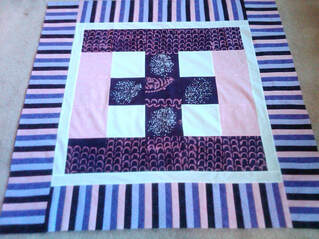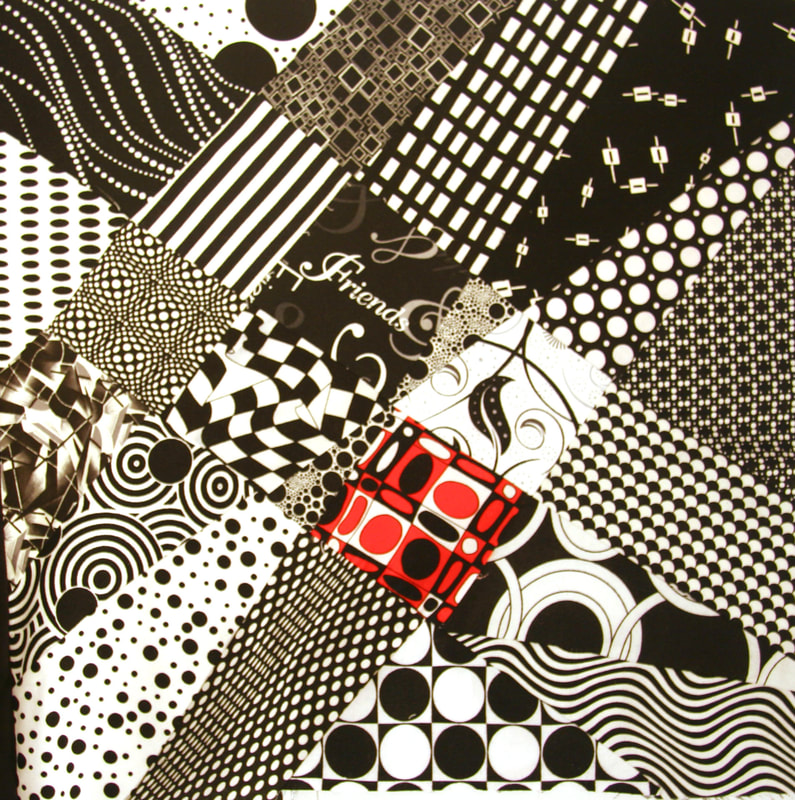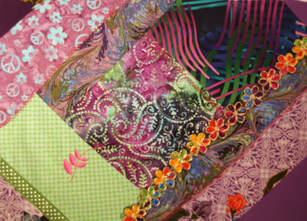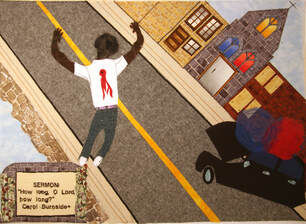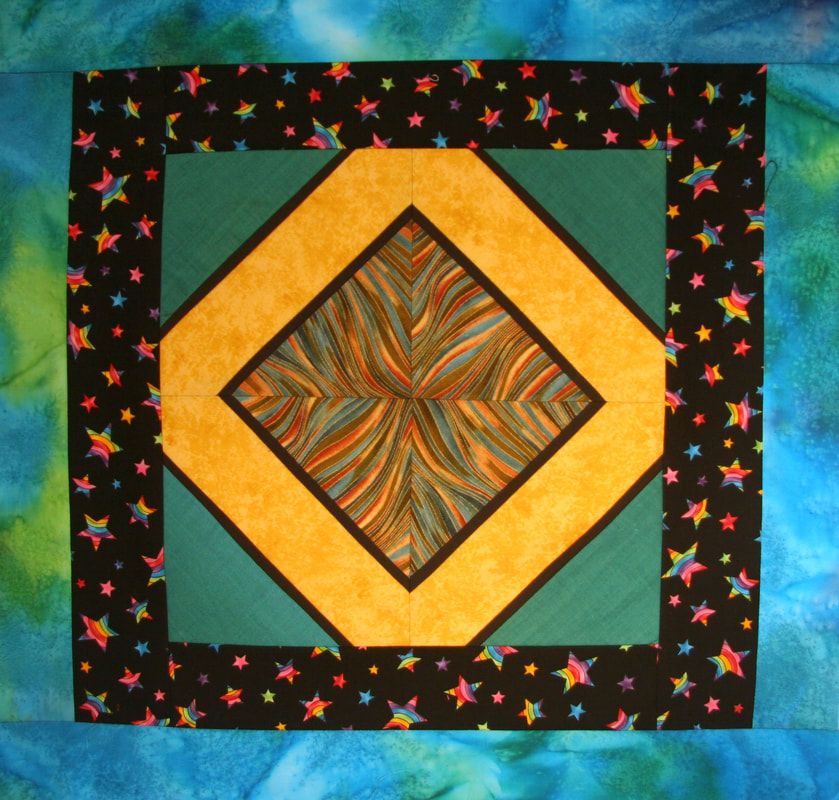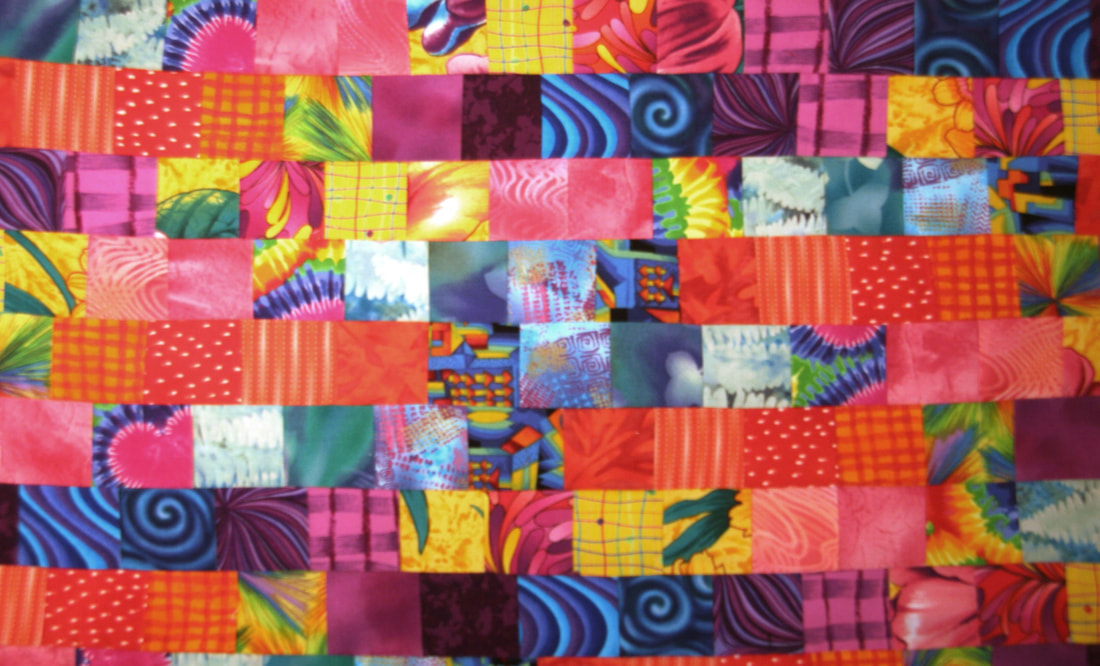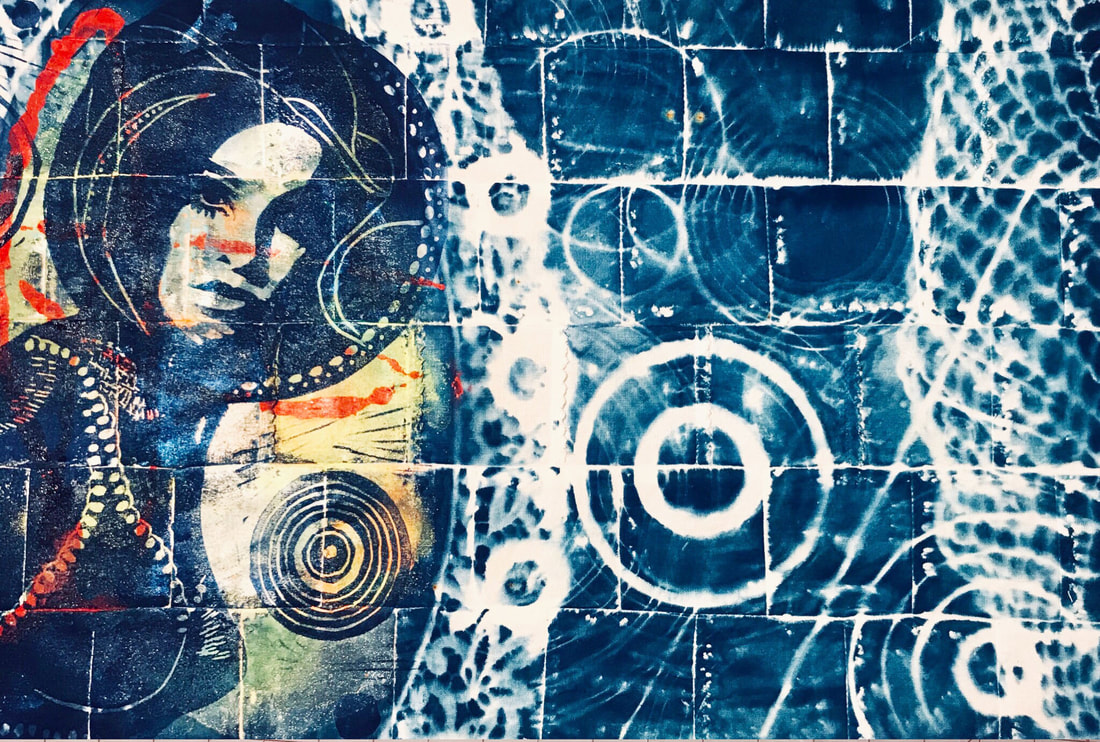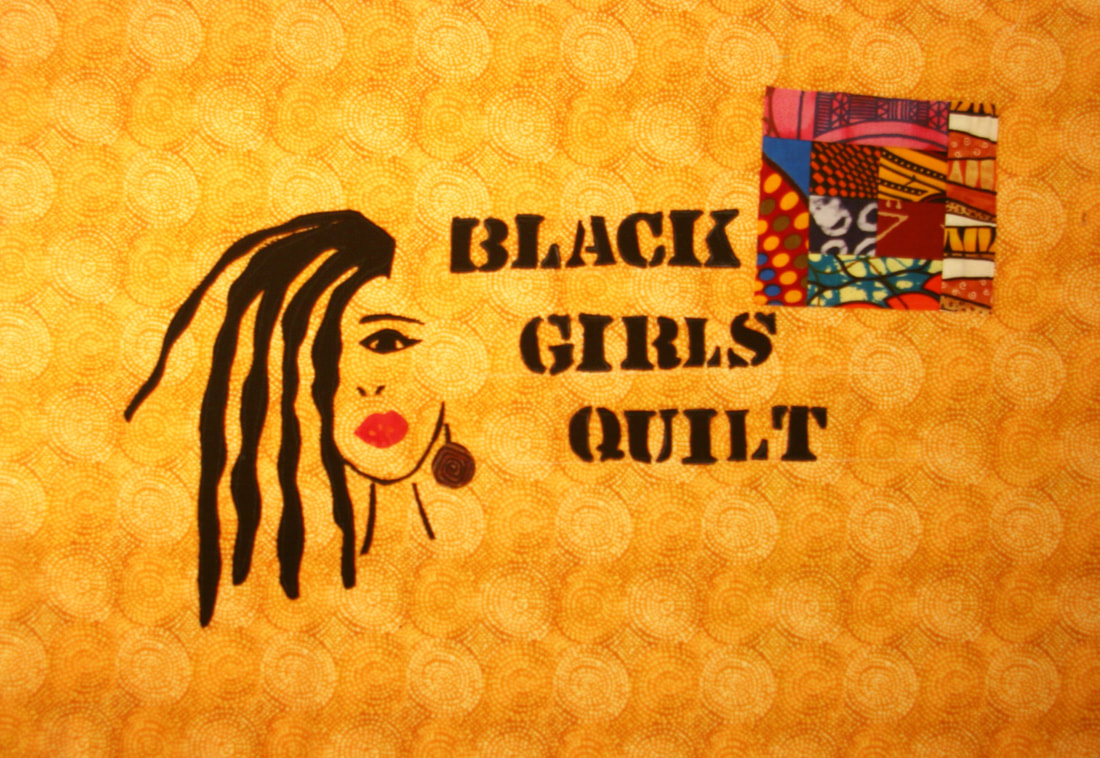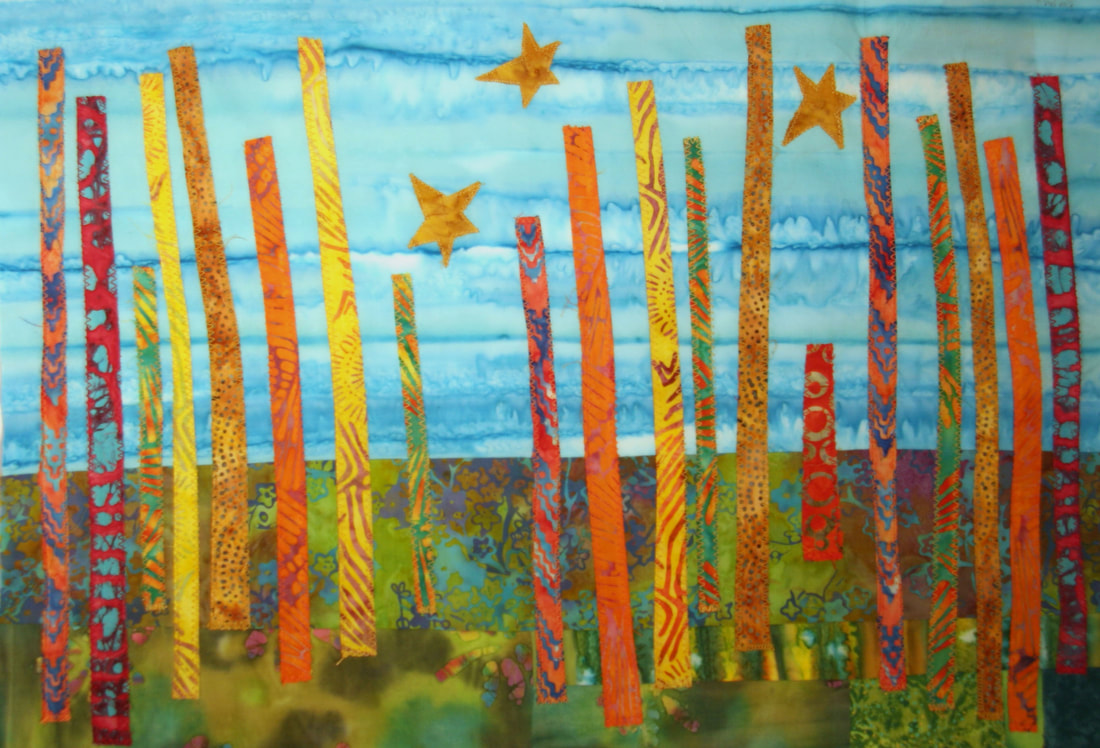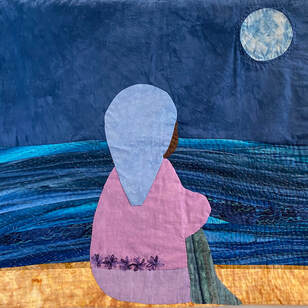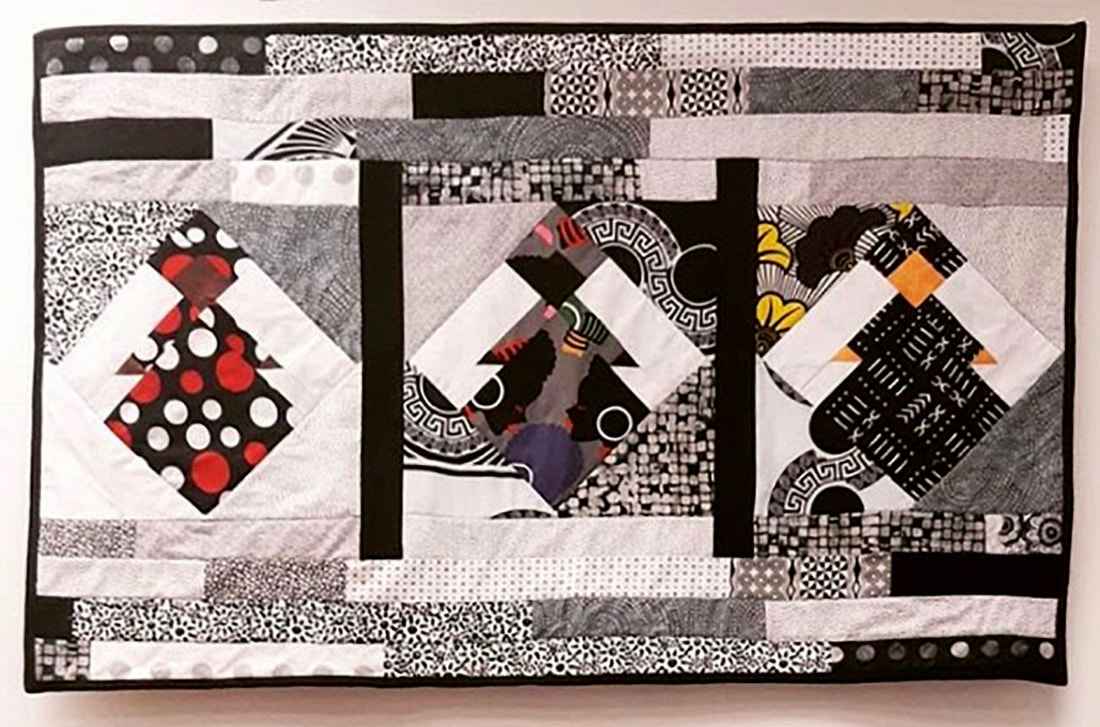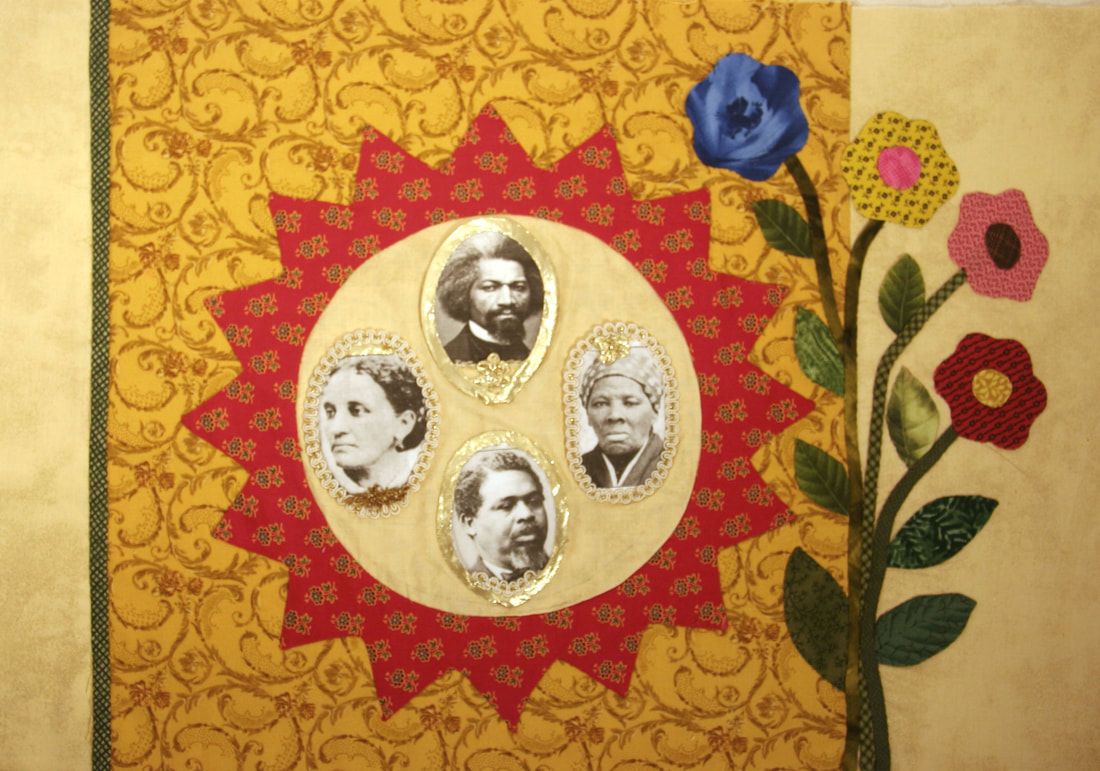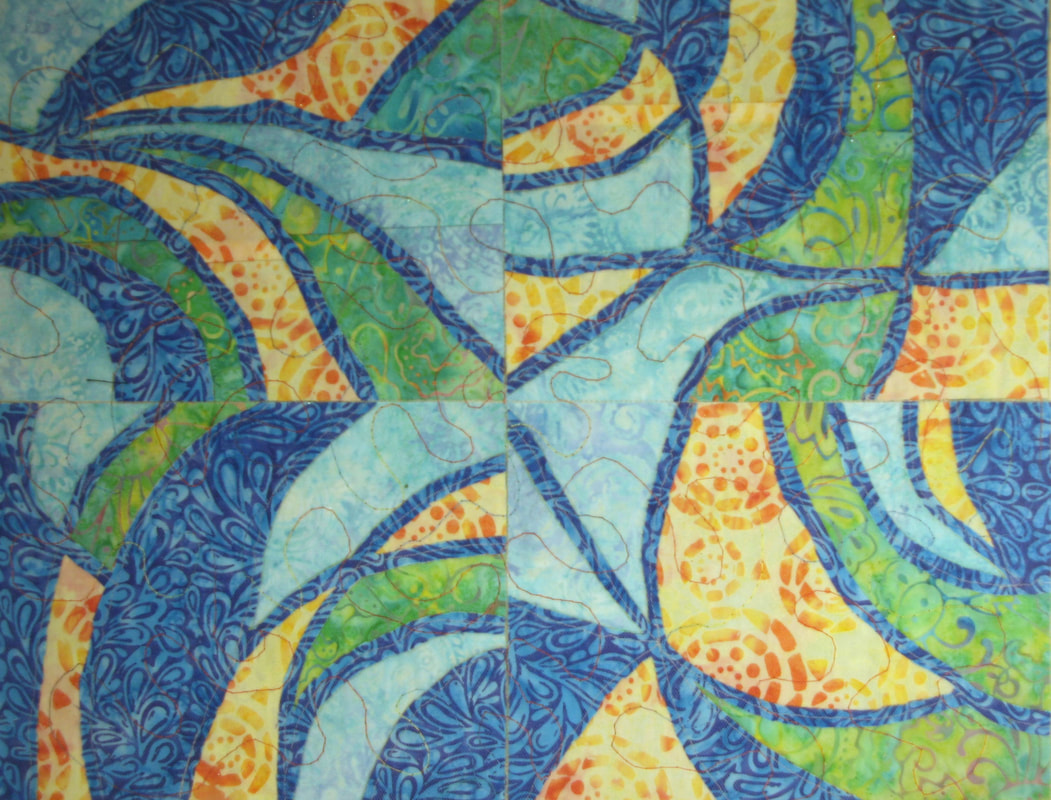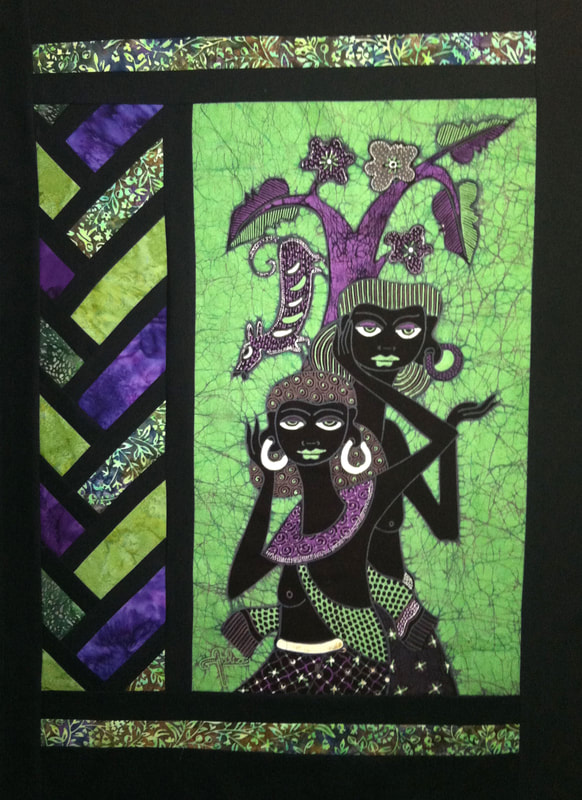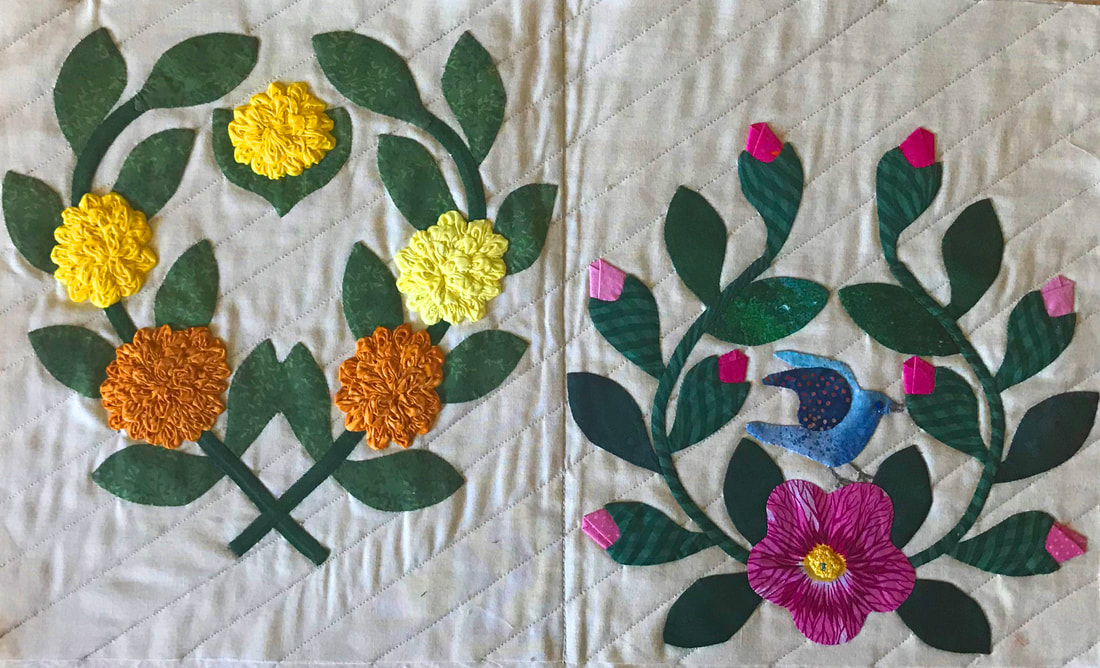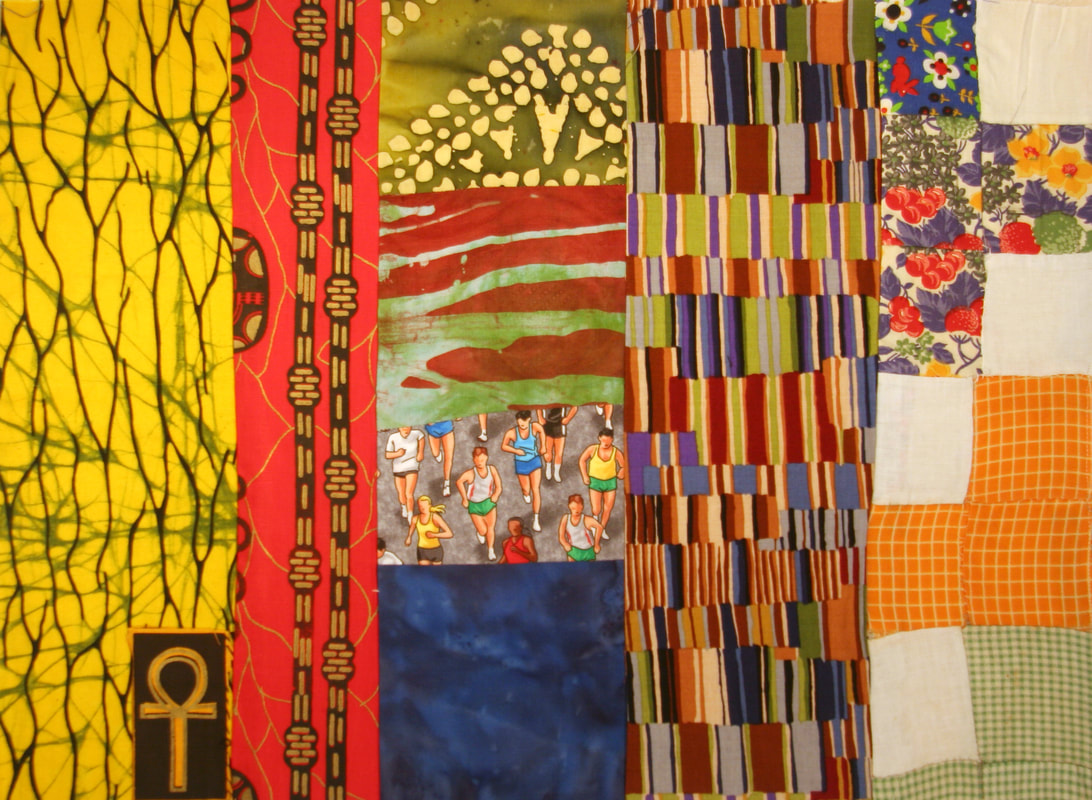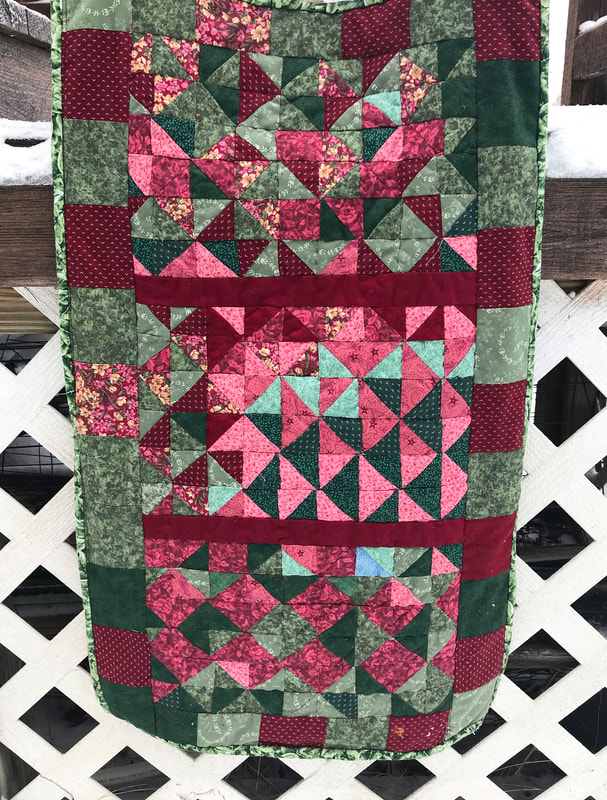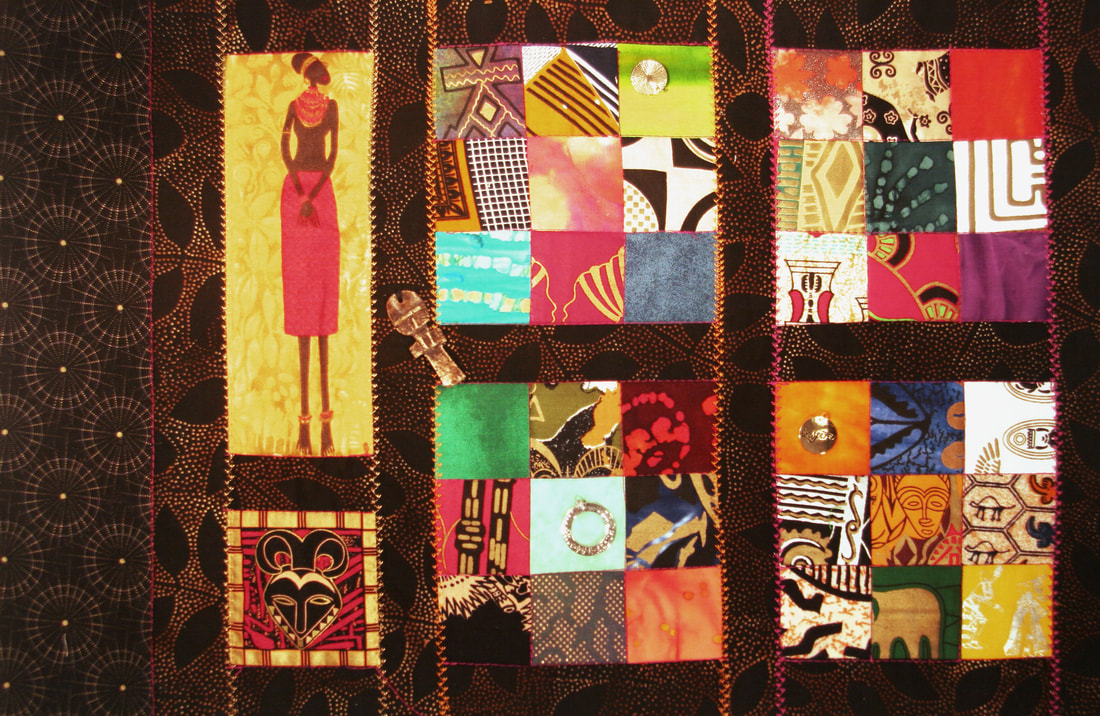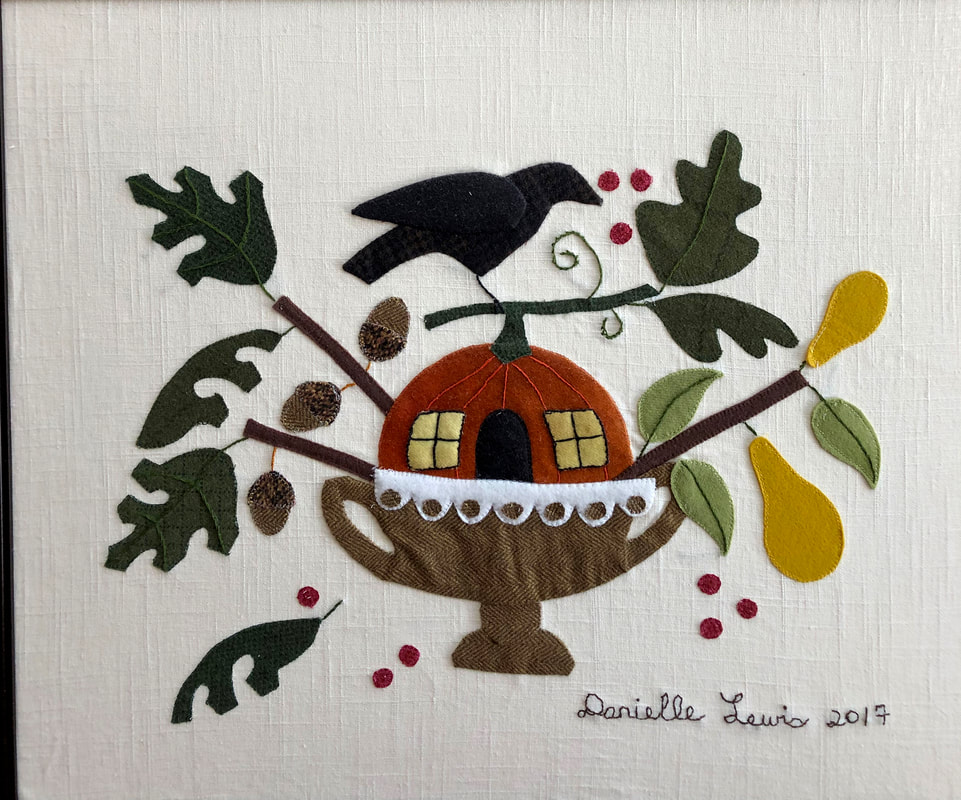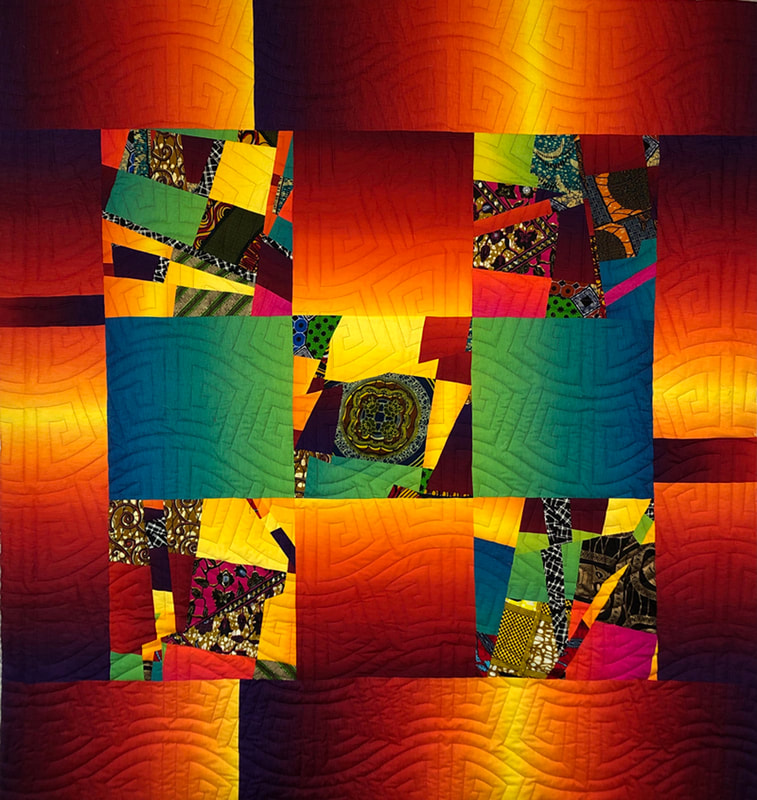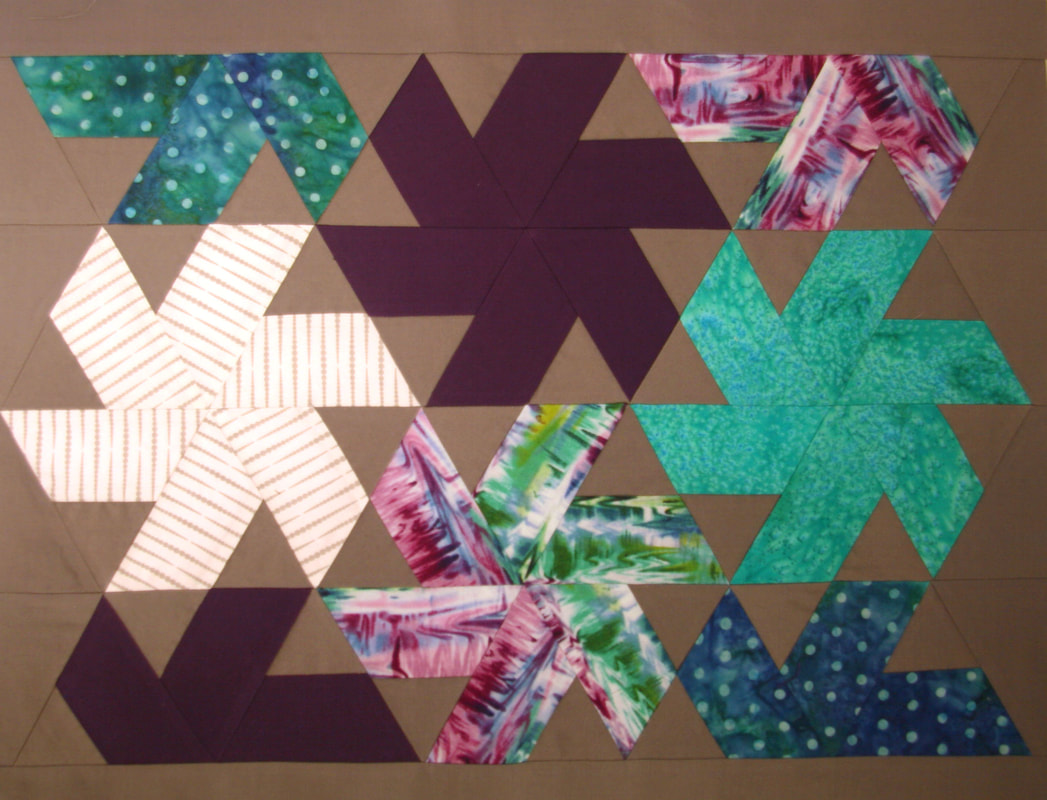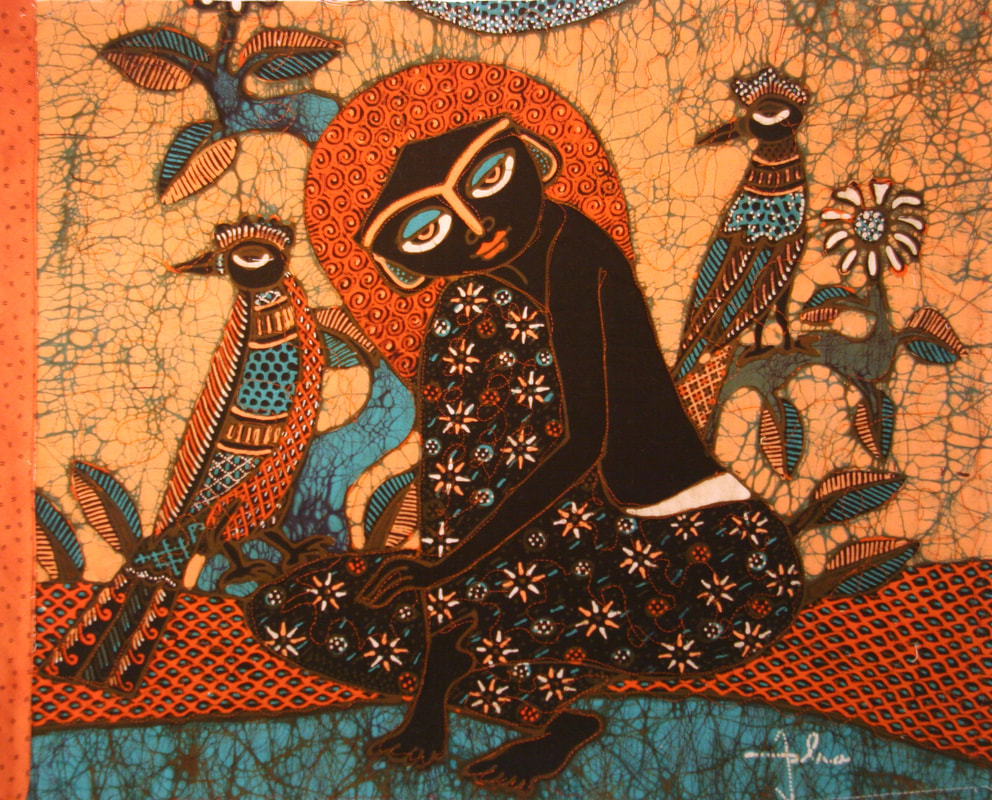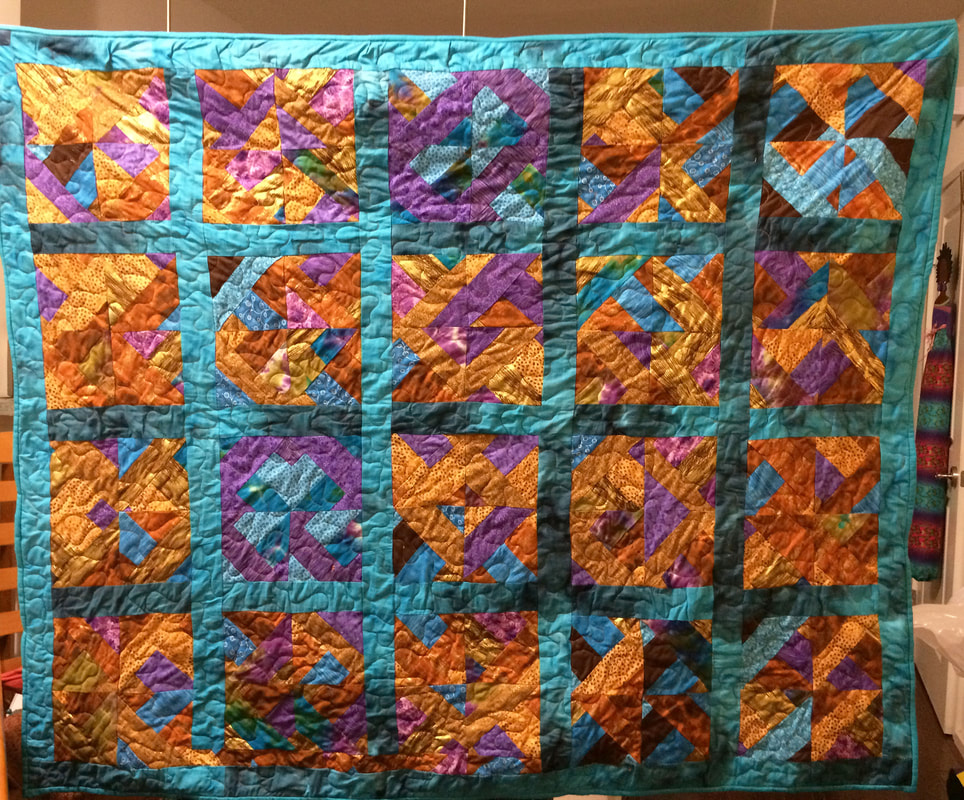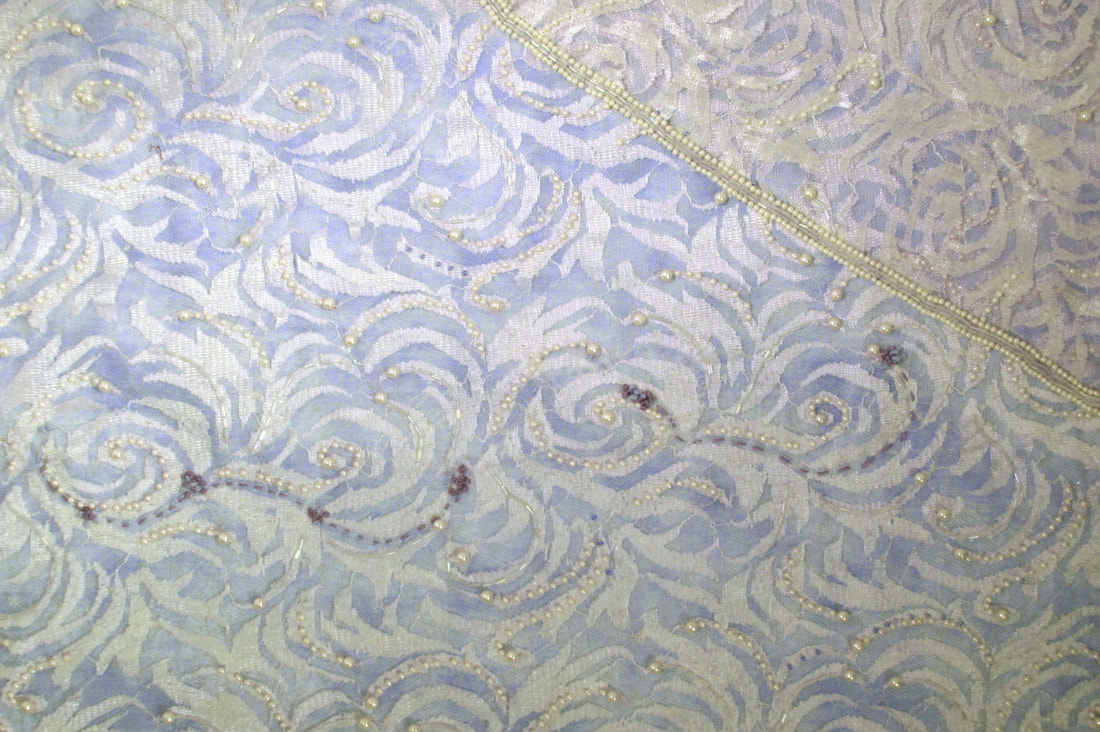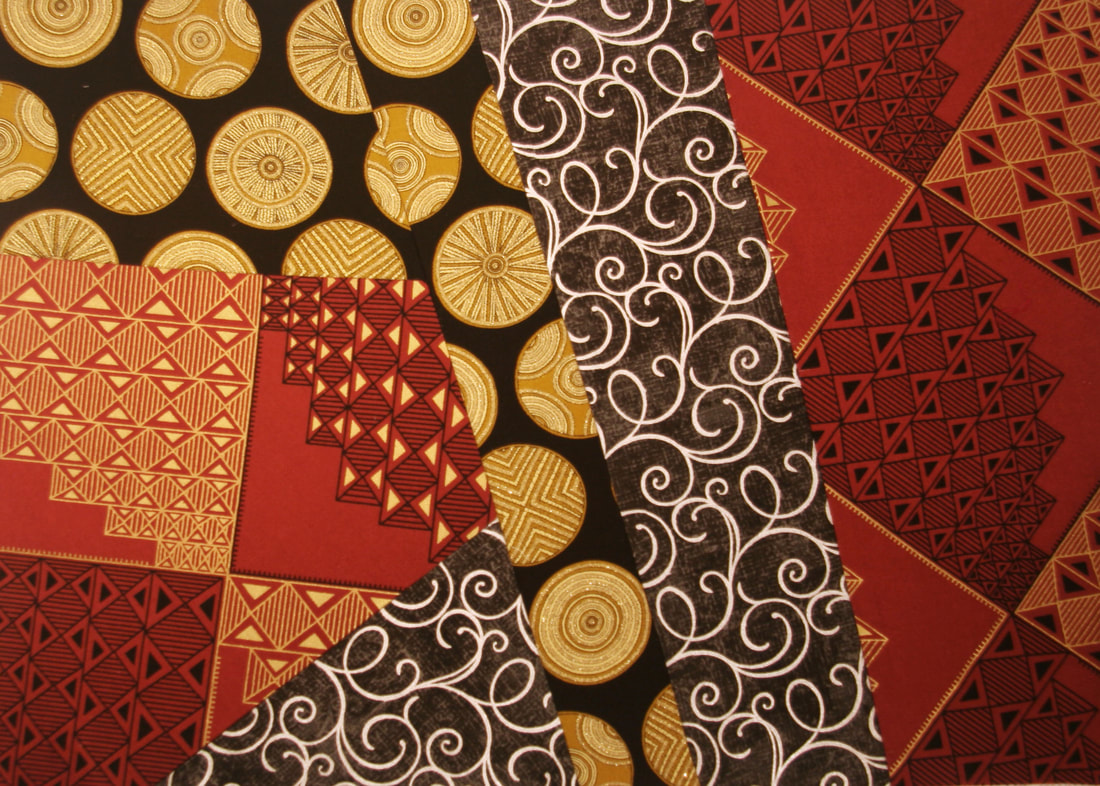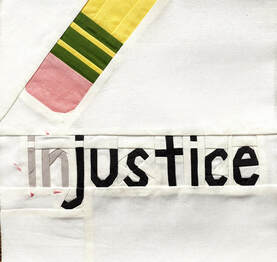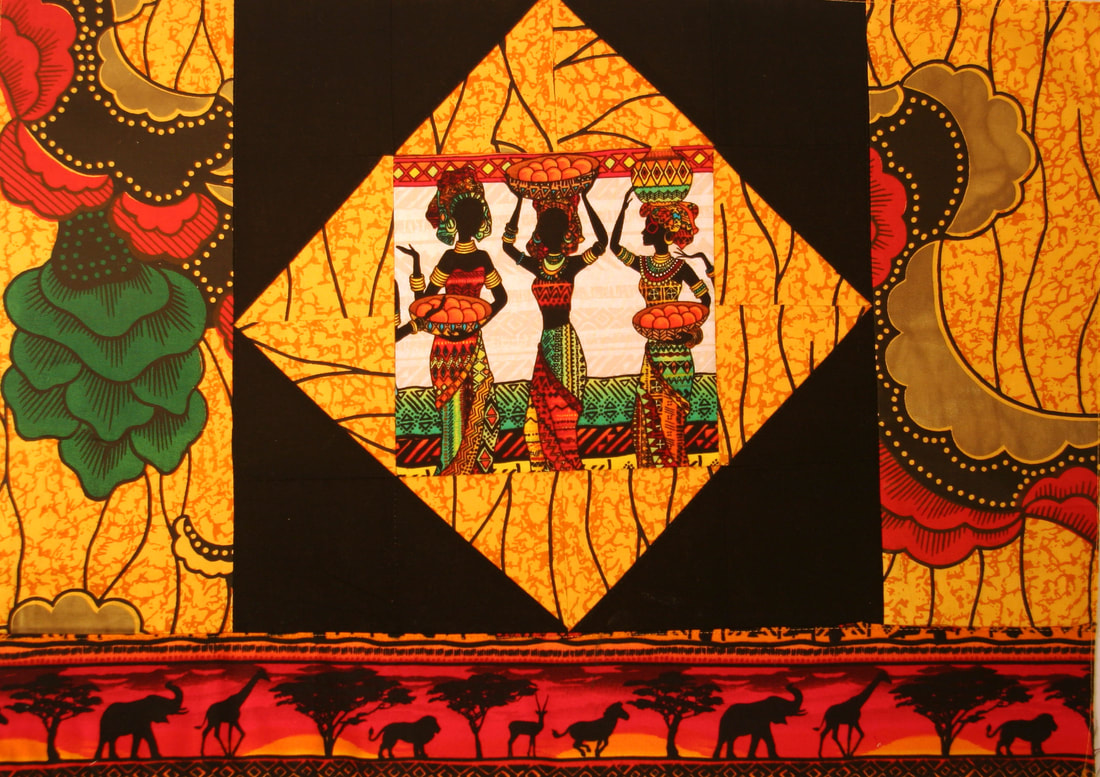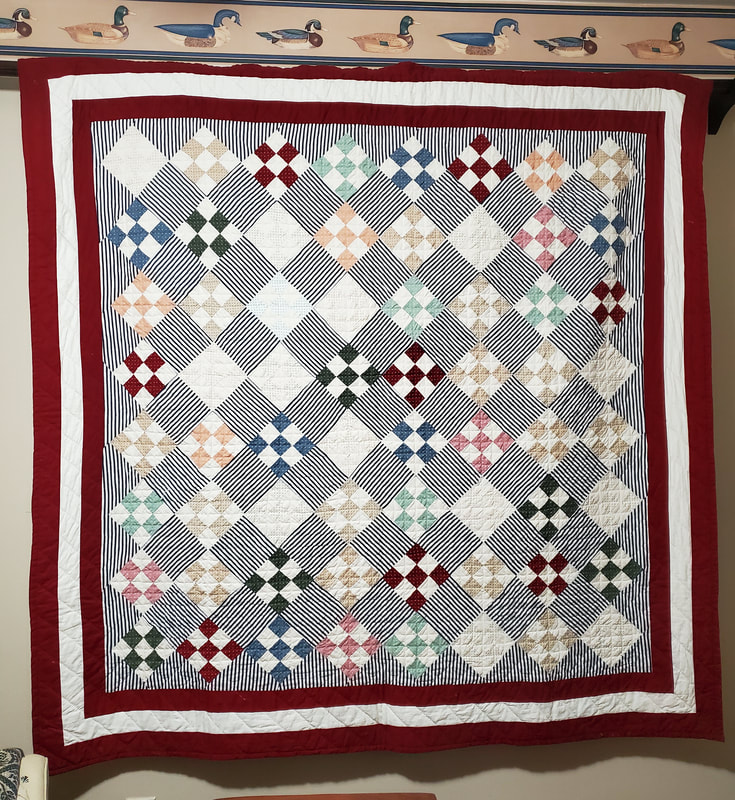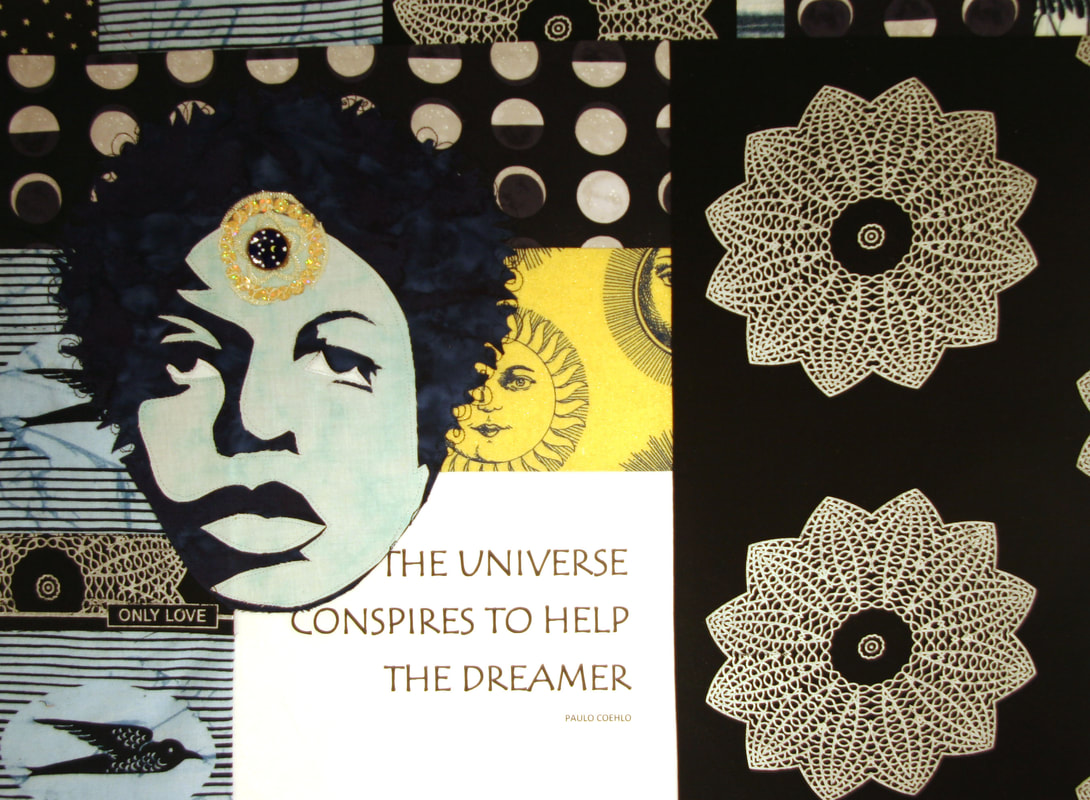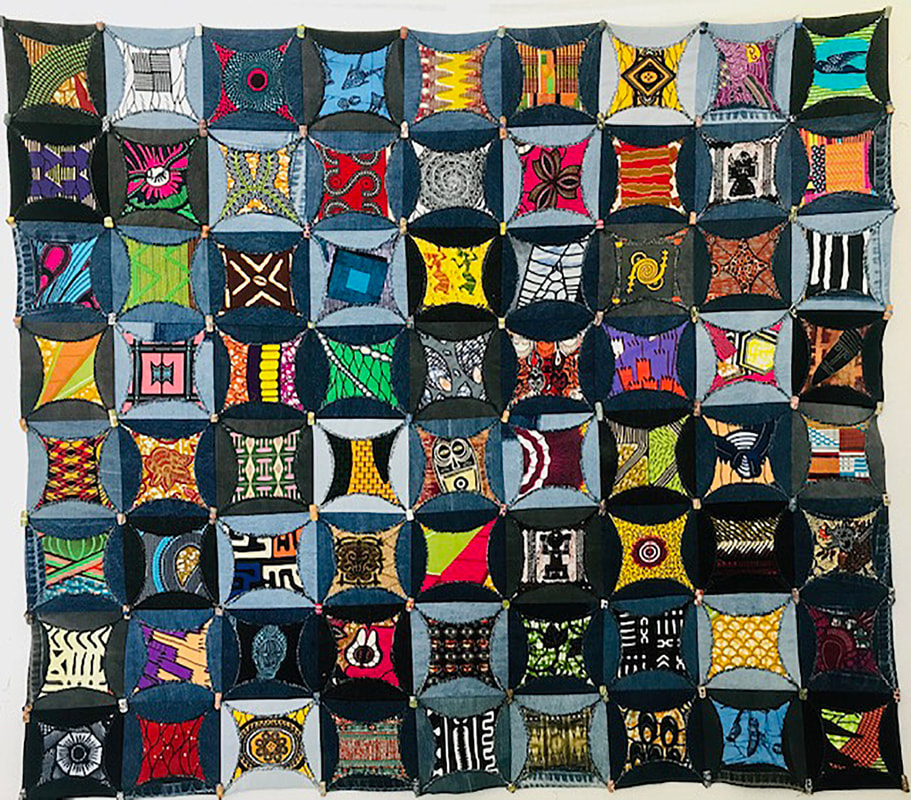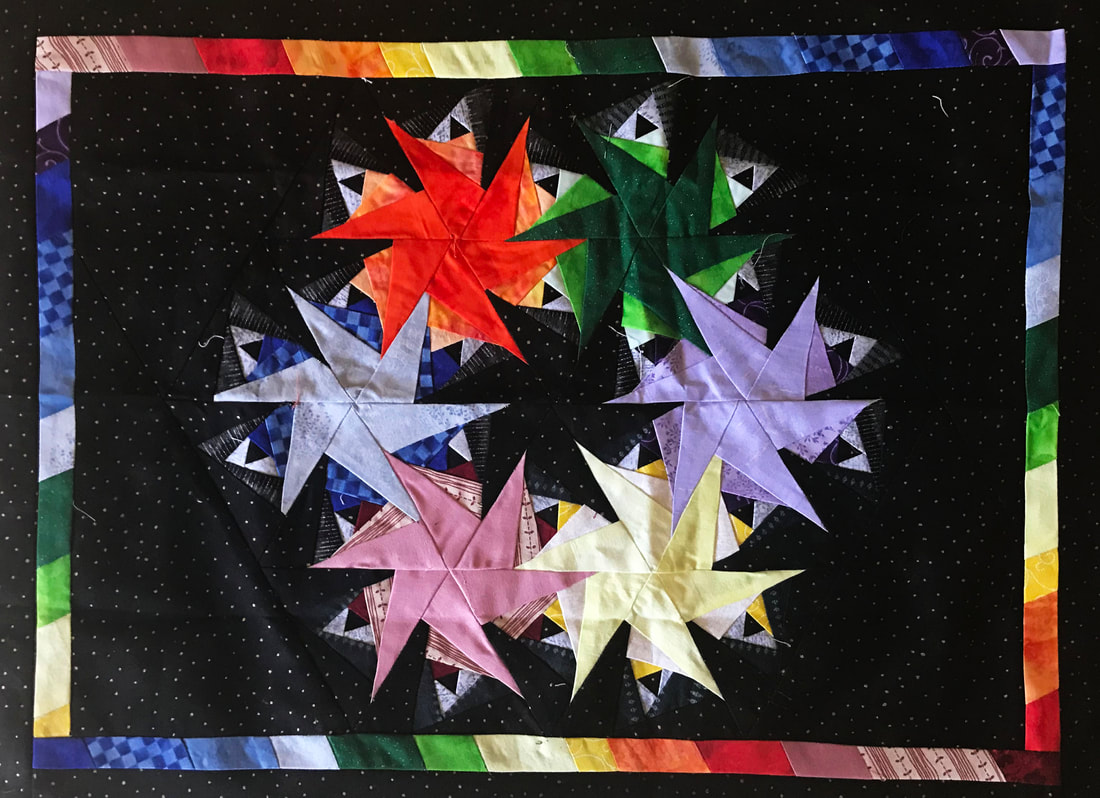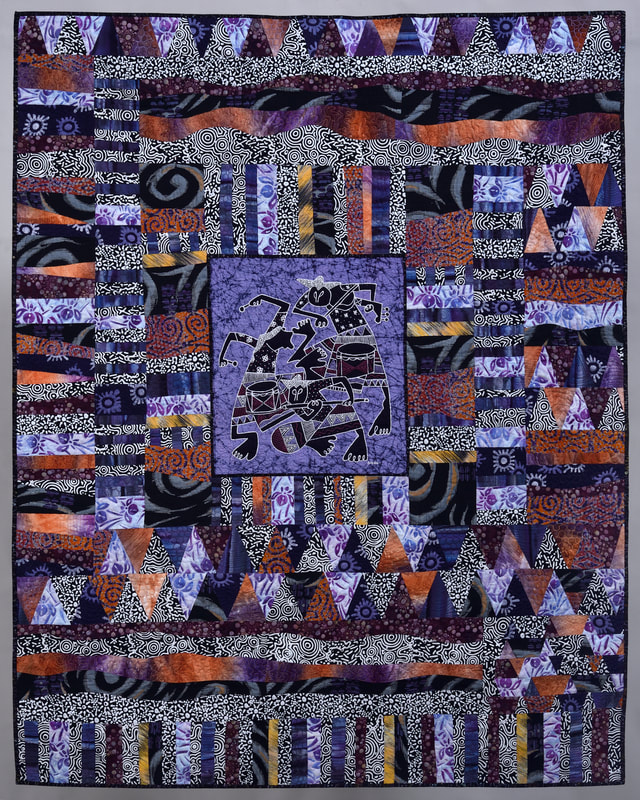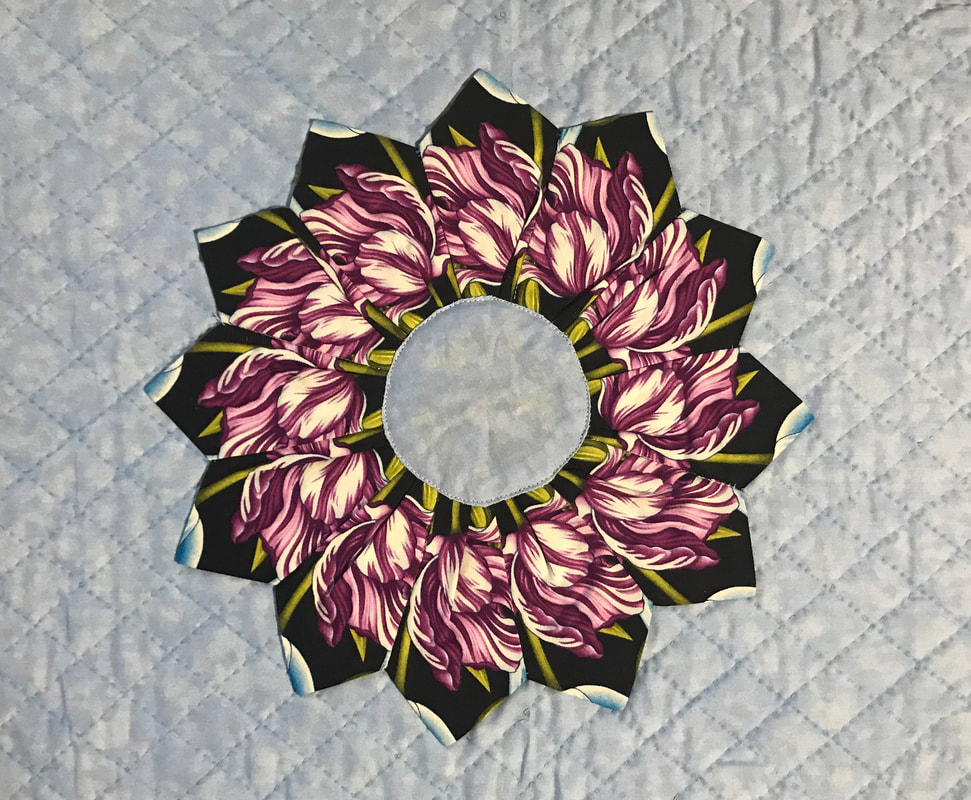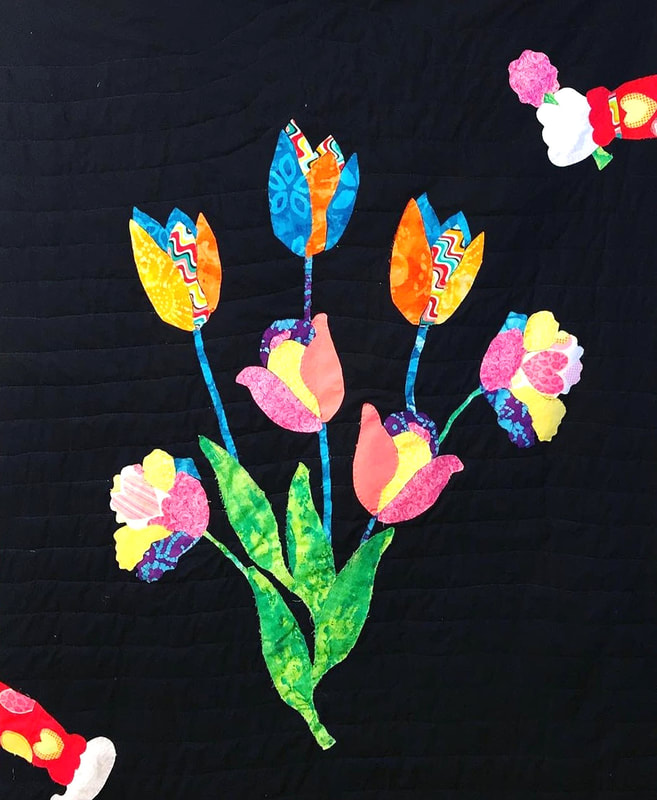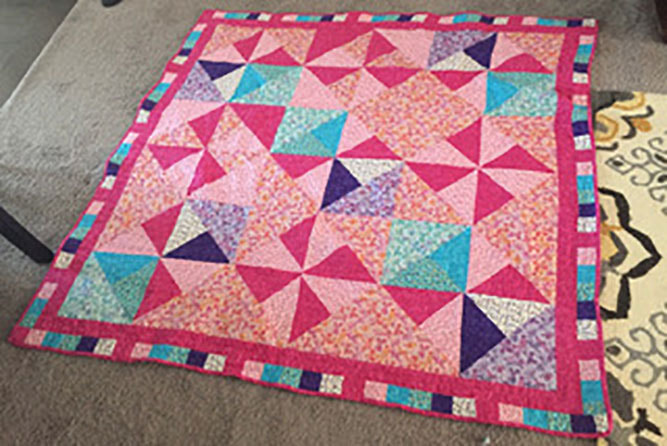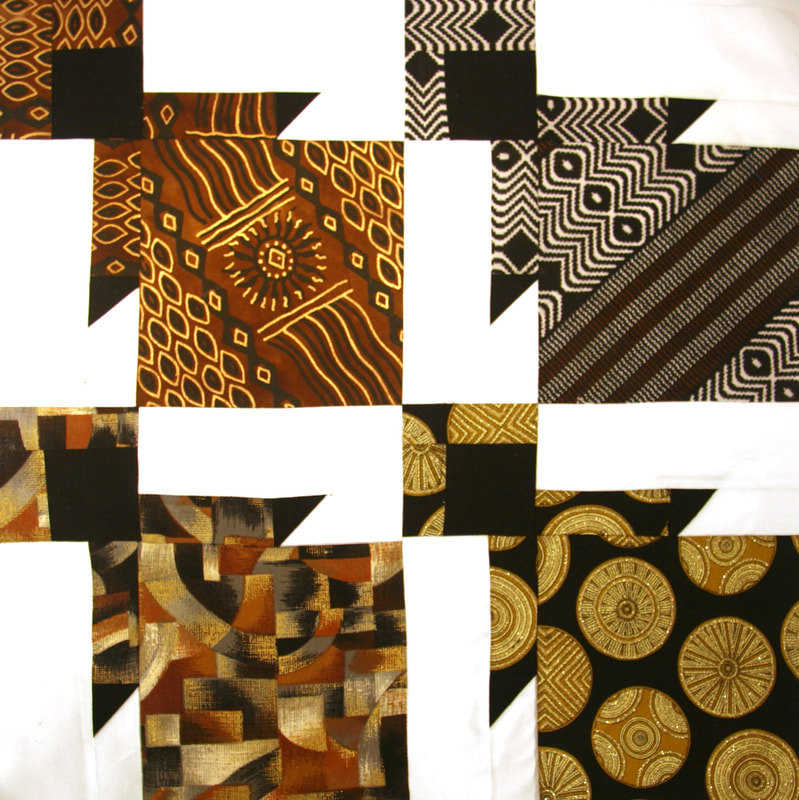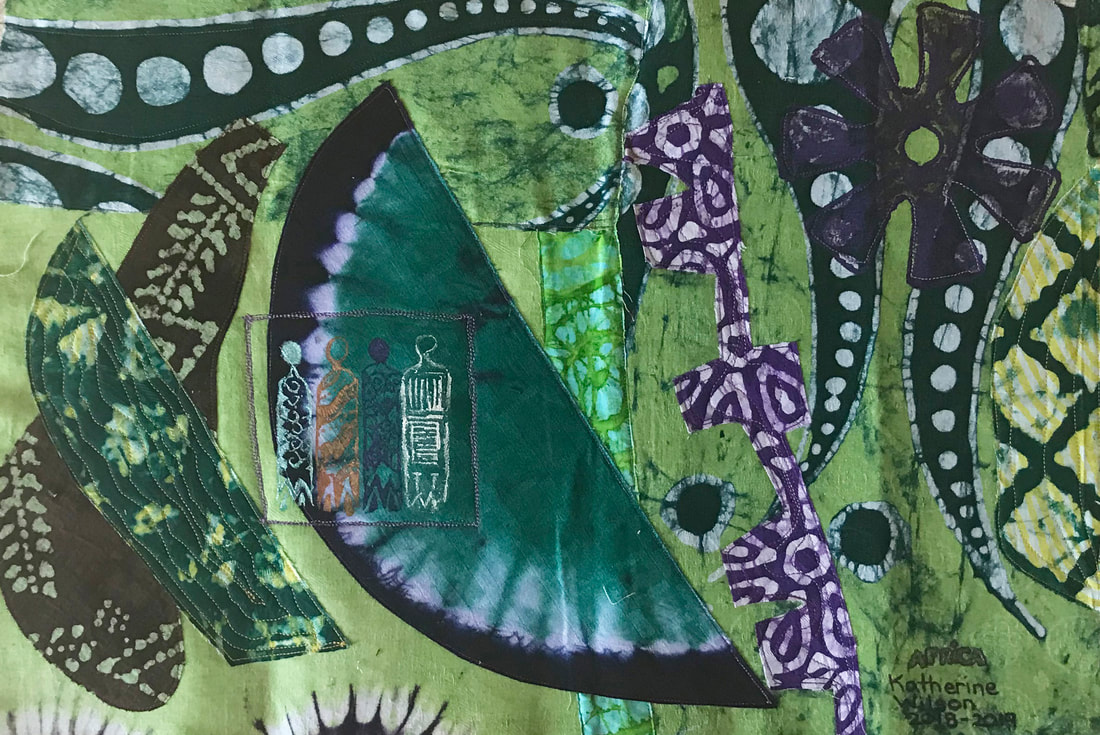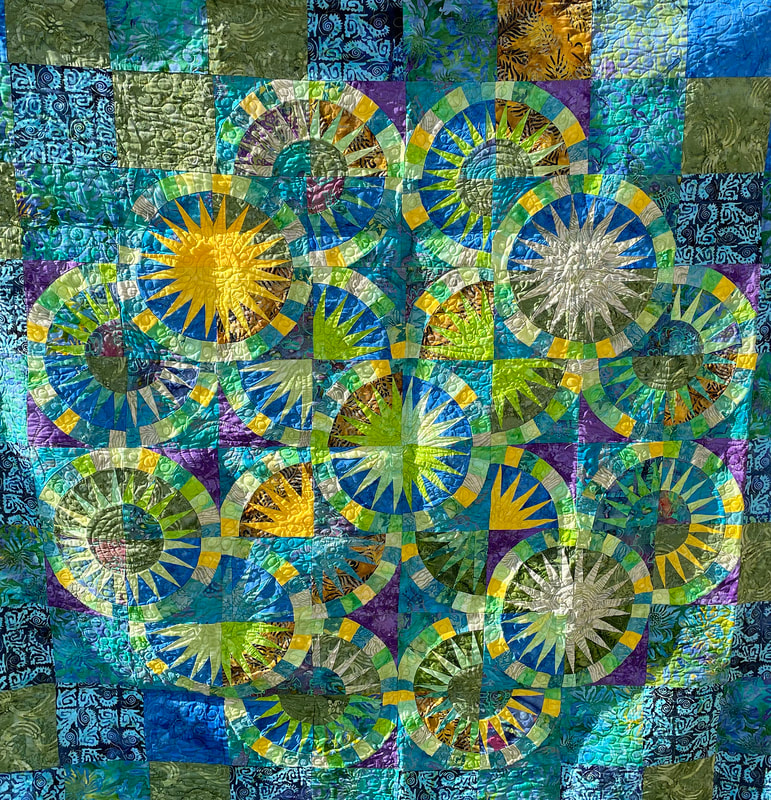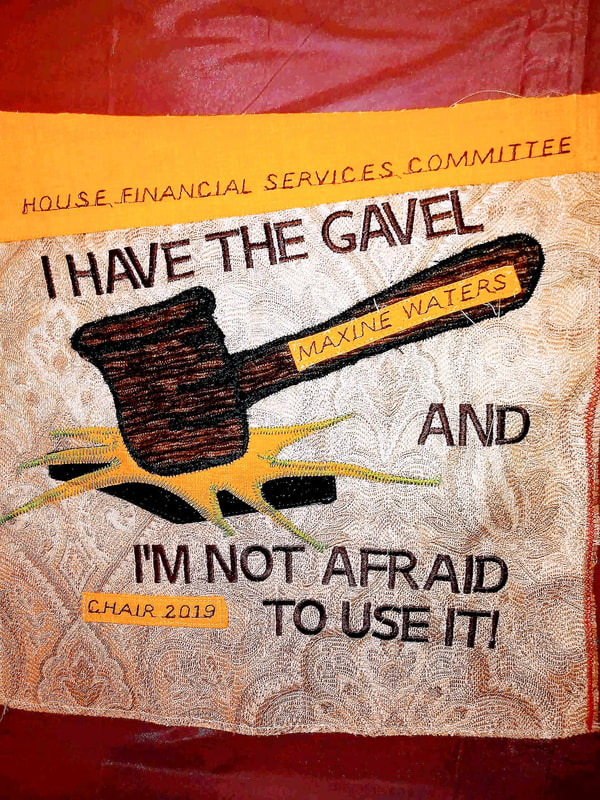The members of AAQB represent the full spectrum of quilting techniques from traditional to contemporary. Here is a sampling of their work along with brief biographies.
|
Denise Bailey-Jones
Denise Bailey-Jones is an Organizational Psychologist, Executive and Leadership Coach and a budding fiber artist. She likes to sew, quilt, draw, and use a hodgepodge of items she has on hand or found to incorporate into her quilts, and wall hangings. Quilting is therapy for her, and a way to support others in their healing process. She uses this creative art form to make comfort quilts, celebratory quilts, fundraiser quilts, and just-because quilts. Quilting is the most creative endeavor Dr. Bailey-Jones has experienced. It has transformed her life. She was introduced to quilting as part of a healing process and has incorporated it in her journey to promote positive change in the lives of others. It allows her to connect with family, friends, and community. |
|
Deborah C. Bassard
Quilting for over 24 years, Deborah makes quilts from old clothing of a loved one and integrated photos. It is the memory of what the quilt presents that is most important to her. She machine-pieces the top of the quilt and then hand quilts or knots the layers together. Deborah feels this technique adds a touch of authenticity to the quilt, as each stitch represents a part of her appreciation of this method of communication with others. All of her quilts have been gifts to others. She believes she puts a piece of herself into each “gift” and wants most for her quilts to just be loved and to be a reflection of that effort in their creation. |
|
Edith Blackwell
I grew up watching my grandmother sewing and quilting. I became interested in sewing first, and about ten years ago I began quilting as a hobby. I find quilting to be very relaxing and enjoyable. I have taken and still take classes in quilting, and they have been helpful and informative. I’ve learned about colors, techniques, and designs. There are always quilt shows exhibiting the work of others, which really peak my interest and give me new ideas. New tools are always being created to make it easier and quicker for the many steps involved in the art of quilting. |
|
Mary Brown
Mary Brown is a native Marylander with a BA degree in Business Management. She is currently the Vice President of AAQB. Mary began quilting after the death of her son in 2009 when her doctor suggested she find something to occupy her time. After attending her first AAQB meeting, she was hooked. At AAQB she met her two mentors, Catherine Wooten and Vera Hall. She credits their help and friendship with guiding her through her quilting journey. |
|
Carol Bustard-Burnside
In 2000, I learned to sew when I wanted to make a priests’ vestments for a seminary friend’s ordination. I made her a chasuble with more than one thousand 2” squares, pieced together to depict my friend’s back yard. I pieced the stole from extra squares leftover from the chasuble. My quilting style has changed over the years, from traditional piecing to original designs of message quilts. In 2015 I began making quilts with messages about systemic racism and white privilege, so other white folks could learn some of what I had learned along the way. The quilts I make range in size and shape. Some are 9 inches and some, like my daughter’s wedding quilt are 125 inches tall. |
|
Marlene Clark
Marlene was first introduced to quilting when her sister-in-law bought a handmade quilt. Marlene immediately became intrigued by the different fabrics and had to purchase her own quilt made from her most cherished African fabrics. Many years later, Marlene attempted to make her first quilt, which was before the advent of the Internet and YouTube, so learning quilting was a bit of a challenge. She began taking classes at a local quilt store and connecting with other women at a quilting guild which eventually led her to form Wee Bee Quilters with eight other women. Within these groups, Marlene learned techniques and found her vision and voice as a quilter. |
|
Jeanette Coleman
I began quilting off and on since 1999. I absolutely love working with fabric and the brighter the colors and prints the better. I took classes with the local fabric stores and quilt shops in Baltimore. I am still evolving and love working with and collecting fabric and quilt/craft books. My goal is to continue learning and have fun with it. |
|
Suzanne Coley
Growing up in an artistic household, Suzanne Coley has been quilting and sewing since she was ten years old. Over the past ten years, she has merged quilting techniques and practices with embroidery in her textile books. Coley’s main artistic field is printmaking and book arts; she has pioneered the style of textile book making called “couture textile books,” combining precision and intentionality of the design with bold experimentation and abstraction. Coley’s fine art textile books are in the permanent collection of the Smithsonian Institution (National Museum of African Art Library) and in the National Museum of Women in the Arts. She is a recipient of a 2020 Rubys grant for her textile books. Please visit her website for more info. |
|
Sandra M. Ealy
I love that each quilt I began poses a challenge to see it through to the end. I’ve fallen in love with art and portrait quilts: It is through these quilts that I feel my creative energy emerging from within. Over time, I have developed my own techniques for creating portraits, and my approaches are still evolving. My paternal grandmother was a quilter. Even though she did not directly share her skill with me or any of her offspring, her passion has been passed to me. I feel my ancestor guide me in creating colorful and beautiful art quilts, shaped by what I have learned from others. My Instagram page is: Yetunde2000 |
|
Kimberly Field
Kimberley began quilting over twenty years ago. She had been collecting fabric scraps from working in theatre where she was a pattern maker for opera as well as regional theatre. She has made traditional quilts, but really enjoys a more free form approach. Seeing the Gee’s Bend show in NYC really gave her the freedom to create whatever she likes, and she has never looked back. Skinny strips of fabric can be trees, fancy metallic netting can become an overlay that mimics Indian handwork. |
|
Juandamarie Gikandi
Inheriting a 1920's quilt made by my Nana’s aunt is my primary inspiration, and inculcated in me a burning desire to learn to quilt. I’ve been quilting for about 15 years, and proud to join my Arkansan ancestors known for their talents with needle and thread. I’m self-taught, and take my cue from the experiences of people who suffered the African Diaspora. I mostly piece by machine and quilt by hand or machine. My focus now is on creating story quilts. My work always contains a bit of "Mother (Ghanaian batik).” I use fabrics I've made or bought in Africa; USA cotton; batiks and wax prints. My works follow my ancestors’ traditions and are mainly utilitarian. I also create pieces that express a myriad of social justice issues. |
|
Christa Gilliam
Christa C. Gilliam is a social work educator, mom and wife living in Baltimore MD. She began sewing for self-care after earning her PhD in 2016 and started her quilting and fiber arts journey in 2018. Quilting has become her passion and when she is not teaching undergraduate social work courses she can be found creating. She loves to use bold prints and scrappy patterns to create unique pieces. Learning to quilt has helped her demonstrate to her colleagues and students, practical ways of incorporating self-care into a busy work-life schedule. Social media has allowed her to chronicle her quilting and fiber arts journey. You can follow her on IG @sewcialwork. |
Kim Hall
Kim F. Hall inherited a love of fabrics from her mother, but made her first quilt with her paternal grandmother, Drusilla Hall, when she was a child. Since then quilting has been her primary creative outlet, sustaining her through health issues, family losses and the perils of being a black woman in academia. She loves bright, bold fabrics and likes to try out new techniques with textiles she has collected from around the world. Her quilts have been on display in Kentucky, Maryland, Massachusetts, North Carolina and New York. She was chosen “Quilter of the Month” at the former Seminole Sampler Quilt shop in Baltimore and her quilt “Duafe” was part of the juried show, “Quilts of the Mid-Atlantic” at the National Quilt Museum in Paducah Kentucky. She is also a member of the Quilters of Color Network of New York.
Kim F. Hall inherited a love of fabrics from her mother, but made her first quilt with her paternal grandmother, Drusilla Hall, when she was a child. Since then quilting has been her primary creative outlet, sustaining her through health issues, family losses and the perils of being a black woman in academia. She loves bright, bold fabrics and likes to try out new techniques with textiles she has collected from around the world. Her quilts have been on display in Kentucky, Maryland, Massachusetts, North Carolina and New York. She was chosen “Quilter of the Month” at the former Seminole Sampler Quilt shop in Baltimore and her quilt “Duafe” was part of the juried show, “Quilts of the Mid-Atlantic” at the National Quilt Museum in Paducah Kentucky. She is also a member of the Quilters of Color Network of New York.
|
Vera Hall
As an educator and a teacher, Vera Hall became active in politics and eventually merged education and politics when she accepted a job as legislative liaison at Morgan State University from 1983-1992. While working at Morgan she successfully ran for a seat on the Baltimore City Council and represented the city’s fifth district from 1987-1995. Vera also held the position of vice chair of the Maryland Democratic Party from 1989-1992 and made history in 1992 when she was elected as the first African American woman chair of a state democratic party, a position she won by just one vote. She is currently retired and devotes herself full-time to quilting and caretaking. You can find out more about her on Historymakers.org. |
|
Brenda Harrington
Brenda Harrington learned how to sew from her mother at an early age. Her whole family makes clothing, including her daughter who is a professional fashion designer. Her interest in quilting came about after a discovery of squares her aunt made and saved in an envelope. Brenda found these packs of squares in her aunt’s apartment after her death. Her end goal was to learn enough about quilting in order to someday piece together her squares with other antique fabric. Now that she is retired she will complete her aunt’s quilt. She cuts the fabrics from yardage and selects, places and sews each small piece. She enjoys the process of piecing together fabrics and seeing the progression along the way. |
Susan Hartman
I made my own clothes through middle school and high school. I experimented with a few small, simple quilts for my children and for baby gifts, and finally tried some larger quilts as young family friends went off to college. Only once was a pattern involved; it was a more free-form artistic expression.
My time at the sewing machine has been limited in recent years, but I spend time daily doing needlework and crochet.
I finished my first “real” quilt last year, a baby quilt that used a pattern and coordinating fabrics. I’d finally begun to flex my quilting muscles! Then AAQB member Jackie Simpson offered a mystery quilt challenge, and I participated in that, turning my small sample into a larger piece for the current show.
I made my own clothes through middle school and high school. I experimented with a few small, simple quilts for my children and for baby gifts, and finally tried some larger quilts as young family friends went off to college. Only once was a pattern involved; it was a more free-form artistic expression.
My time at the sewing machine has been limited in recent years, but I spend time daily doing needlework and crochet.
I finished my first “real” quilt last year, a baby quilt that used a pattern and coordinating fabrics. I’d finally begun to flex my quilting muscles! Then AAQB member Jackie Simpson offered a mystery quilt challenge, and I participated in that, turning my small sample into a larger piece for the current show.
|
Patricia House
Patricia made her very first quilt over ten years ago, but didn’t become a serious quilter until a couple of years ago. Her inspiration comes from the beautiful quilts made by Catherine Wooten, who along with Vera Hall have become her mentors. They have formed a small group of quilters who meet weekly. This group has been a great source of enjoyment, inspiration, and learning. Patricia uses richly colored fabrics she purchases during her yearly trips to Asia or Africa. |
|
Gwen Hunt
At the age of 11 years old, my grandmother taught me how to piece small blocks when I lived with her in Texas for a year. Fast forward to 1986, I had finished receiving my degree and needed something to do with all that pent up energy. I saw an article in Essence magazine about Carolyn Mazloomi and women of color quilting. I contacted her about quilting clubs in my area. I also saw an article about AAQB having a quilt show in the Washington Post newspaper. I attended and I was sold on quilting again. I joined AAQB and took a basic quilting class to brush up on my skills. I started out making traditional quilts and moved on to art quilts. I continue to try different methods including crazy quilts and modern quilts. |
|
Mildred Johnson
My interest in quilting began when I was a little girl around the age of eleven. My mother had her living room set upholstered and had some scraps left over. I decided to make a little quilt with those scraps. Since then I wanted to learn how to quilt. After I retired I decided to take classes. I was at a “home show” at the community center and met a quilter. She had some of her quilts on display. We talked and she told me she taught quilting at Bears Paw. She took my name and phone number. I took several classes at Bears Paw, Seminole, and other places. I enjoy quilting and the different designs you can use to make quilts. |
|
Jacqueline R. Jones
Jacqueline holds a B.S in Education from Bowie State University, M.S. in Curriculum and Instruction from McDaniel College, and a M.A. from The Wesley Theological Seminary. As a retired educator, Jacqueline advocates for diabetes awareness, facilitates a diabetes support group at St. Mark's United Methodist Church, coordinates an annual 5K Run/Walk for Diabetes, and serves on the President's Patient and Family Council for the University of Maryland Medical Center. Jacqueline enjoys jazz, walking, downhill skiing, quilting, gardening, learning new things, and spending time with family and friends. |
|
Jasaiya Keyes
At sixteen years old, Jasaiya Keyes is the youngest member of AAQB. She was raised in a very artistic household and loves working with textiles and fabric. She began quilting four years ago when she was staying with her aunt Suzanne Coley in Baltimore. As an aspiring director, she has found quilting a great way to learn how to create patterns using different fabrics in a cohesive manner- similar to inventing a story with visuals that represent it. While doing this, she created her first quilt and is deeply proud of it. Though it took a lot of time and effort, the work wasn’t as tedious as she imagined it to be. |
|
Deborah Kinsey
Born in Baltimore, Deborah Kinsey has loved quilts and the arts from an early age. However, it was during her career at the Social Security Administration in Woodlawn, MD where she met ladies in a quilting group called Sew and Tell. It is with this group that she began to hone her quilting skills. They encouraged her to take some quilt classes and since 1999 she has made several large sampler quilts and a variety of quilt sizes and styles for her family members and friends. She enjoys quilting in various and diverse styles including making traditional blocks, modern blocks, crazy patch, appliqué, photomosaic, round robin group quilts, landscape, and art quilts. Deborah also has a small collection of antique quilts. |
Dr. Brenda Lorick
Dr. Brenda Lorick’s love of learning is exemplified by earning advanced degrees from Howard University, St. John’s College and Texas A&M University. Her quilting style has been influenced by several contemporary African American fiber artists. The Bmore Arabbers quilt was inspired by cherished memories of these colorful and melodious vendors who were a traditional and necessary staple in her childhood Sandtown neighborhood. An apt word picture of these delightful and fascinating entrepreneurs was captured by Antero Pietila in his book, The Ghost of Johns Hopkins. Her hope is that this debut quilt portrays the warmth, vigor, and comforting joy these weekly visitors brought to many neighborhood food deserts that still exist in Baltimore.
Dr. Brenda Lorick’s love of learning is exemplified by earning advanced degrees from Howard University, St. John’s College and Texas A&M University. Her quilting style has been influenced by several contemporary African American fiber artists. The Bmore Arabbers quilt was inspired by cherished memories of these colorful and melodious vendors who were a traditional and necessary staple in her childhood Sandtown neighborhood. An apt word picture of these delightful and fascinating entrepreneurs was captured by Antero Pietila in his book, The Ghost of Johns Hopkins. Her hope is that this debut quilt portrays the warmth, vigor, and comforting joy these weekly visitors brought to many neighborhood food deserts that still exist in Baltimore.
|
Carole Lyles Shaw
Carole Lyles Shaw is a modern quilt designer, author and workshop teacher. Carole started quilting over 20 years ago. She was mentored by the heirloom quilters of AAQB. She co-founded the Sarasota Modern Quilt Guild and served on the Board of Directors of the Modern Quilt Guild from 2015-2017. Carole is the author of Madly Modern Quilts and Patriotic Modern Quilts and modern quilt patterns. Her work has been juried into the Modern Quilt Guild Showcase at the 2018 International Quilt Festival in Houston; QuiltCon 2019; American Quilter’s Society QuiltWeek in Paducah (September 2018); Modern Quilts: Redesigning Traditions at the Ontario California Museum of History and Art (2016) and the Modern Quilt Guild Exhibit at the Texas Quilt Museum (2016). For information about her workshops and lectures, visit www.CaroleLylesShaw.com |
|
Tonya Mason
Dr. Tonya Mason has known how to sew since she was a child. She taught herself to quilt in 2017 using books and online videos. She has always enjoyed hobbies that involved cutting things apart to build new things. Over the years, her hobbies have included stained glass, woodworking/carpentry, and sewing. She found quilting to be fascinating so she decided to teach herself to quilt. Quilting is a challenge. It's much harder than it looks! Seeing beautiful patterns that require her to learn new techniques inspire her practice. She loves the designs and the challenges of construction, and she mostly focuses on patchwork patterns. The dimensions and hues of the fabric pieces create varied imagery and color combinations. |
|
Mary Matthews
Mary Matthews began quilting after attending a sewing retreat in Deep Creek Lake several years ago. She thought she was just going to read. Well, the quilting bugs bit her and now has created numerous quilts. Her grandmother Mariah made beautiful quilts and her mother, Catherine Wooten is a master quilter. Mary is sustaining her family quilting tradition and enjoys weekly quilting bees with members of AAQB. She describes these moments quilting as encouraging and joyful experiences. |
|
Gladis McKoy
My name is Gladis Boyd-McKoy. I am the eldest of nine children. I spent most of my time sewing for my siblings and myself. I never really learned how to be a kid especially that my childhood comprised of jumping one task to another. I always found time to sew, this was a release. Then I was introduced to quilting by a friend; that was a game changer. Now I am addicted to quilting. I have many quilts and quilted jackets that I have done for friends and family. |
|
Linda Meadows
History and art enthusiast Linda Mose Meadows has always been intrigued with the beauty and design of quilts. Her quilts often incorporate vibrant, fabrics, yarns, twine, photographs, beads and cowrie shells. Each piece celebrates her appreciation of God‘s presence, love, life and family and the African Diaspora. Her subjects reflect spiritual strength and a rich ancestry. She has enjoyed being an inspirational blogger, author, poet, public speaker, and academic administrator at Hampton University. Linda grew up in Buffalo, NY, graduated from Howard University (BA) 79’ and State University of New York at Buffalo, (MS)81’. Linda’s upbringing encouraged a love of arts, public service, education and community engagement. She is grateful to be part of such a phenomenal collective of quilters as AAQB. |
|
Karen Nelson
Karen first read about quilts in a book at her childhood library in Brooklyn, NY. The book inspired her to quilt using leftover fabric scraps from clothing her mother made for family members. Karen began piecing quilts by hand and enjoyed sewing. However, because she was so young, her family felt she should spend her childhood days playing outside. She would think about colors and fabrics during those young years, and into early adulthood. She completed her first quilt shortly before the birth of her first child and has been quilting ever since that time. Sometimes, she includes stories or poems to go along with her quilts. |
|
Melinda Newton
I quilted for a few years in the late 90's, then picked it up again in 2009 and haven't looked back. I enjoy mixing techniques of foundation paper piecing, inset curves, needle turn applique, curved piecing, embroidery, English paper piecing and hand carved stamping to make my designs. I'm also involved with the Social Justice Sewing Academy as a youth workshop facilitator, embroiderer and collaborator on youth social justice pieces. Some of those SJSA collaborations have hung at QuiltCon and in galleries in the Oakland area. I've also contributed to the SJSA Remembrance Project. My block was for Freddie Gray. I also designed a SJSA BOM for the National Quilt Museum, January 2020. The best place to see my current work is on Instagram. |
|
Amy Powell
I stumbled into quilting in 1999, but before I could get deeply involved, I was diagnosed with stage 2 breast cancer. My survival of this scary situation, coping with my mother’s deteriorating dementia, and the sudden death of my only brother sent me directly to the sewing machine. Quilting literally saved my life! Since that time, I have become thoroughly addicted making more than 60 bed-size quilts, dozens of lap quilts, scores of tote bags, and numerous other quilt projects. I have taught classes for beginners and experienced quilters, including a 3-year series for a local senior agency. My proudest quilting achievement was in 2016 when a motion picture company purchased one of my quilts and featured it in the movie “Almost Christmas” starring Danny Glover. |
|
Clarissa Price
I have been quilting for 41 years. I got into quilting from my love of antiques. I was a home economics teacher so sewing was not a problem. But to my dismay making quilt blocks was not that easy. Verdene Schmoke and Barbara Pietila helped me to hone in on my quilting skills. What I do now is quilt restoration. I work only on antique quilt tops. I love hand quilting. It gives the quilt a definition that only can be done by hand. Quilts connect me to the past. Our ancestors made quilts to keep their families warm and we still follow the same traditions, making quilts to keep us warm, to beautify our homes and to admire their beauty |
|
Glenda Richardson
Glenda Richardson is a Baltimore-based fiber artist who began making quilts in 1995. She found a supportive community in AAQB, learning that a quilt is a powerful vehicle for artistic expression and for conveying the story of a shared history. Her work consists of emotionally charged portraits, social commentary and improvisational work employing unconventional and repurposed textiles. Since 2017 it has been Glenda’s honor to serve as President of the African American Quilters of Baltimore. Learn more about her at: glendarichardson.com |
|
Rosalind Robinson
Rosalind Ford Robinson was a Home Economics teacher for 38 years, and she has been immersed in various forms of sewing her whole life. After retiring from a profession in teaching, Rosalind began the teaching program for AAQB. She has facilitated quilting workshops and collaborations with faculty and students at Maryland Institute College of Art Quilt Clubs. Rosalind has exhibited quilts in numerous galleries and museums in Maryland. As a member of The Benjamin Banneker Museum Quilting Circle, Rosalind participated in the collaborative project to depict the life and legacy of Benjamin Banneker in a quilt. The quilt is on permanent exhibition at the Benjamin Banneker Historical Park and Museum, in Catonsville, MD. |
|
Jacquelyn Simpson
Jacquelyn has been sewing for more than fifty years. She is a traditional quilter, creating meticulously cut geometric blocks to form spectacular kaleidoscopic gems. Her favorite technique is foundation or paper piecing. There is no greater joy than creating a complicated quilt and designing it as she goes along. To finish a quilt, she used to hand quilt, but as time has gone by, she finds herself machine quilting. Her passion is innate, spiritual, and at times, literally amazes her -- especially when a quilt is completed. She must ask herself, “Did I do that?” |
|
Sandra Smith
Sandra Smith, a Silver Spring, MD based fiber artist, has been creating quilt art, lecturing, and teaching quilting techniques since the early 1980s. Her body of work represents both traditional and contemporary design styles and is composed primarily of art, not bed quilts. Every piece is unique. Her favorite techniques include working with fabric to create transparencies and designing without templates. The variety keeps the opposite sides of her brain busy and that helps to keep her life balanced. One is very detailed and requires a lot of concentration, the other is extemporaneous. Sandra has exhibited her work in major museums and galleries throughout the United States. You can view many of her finished quilts and some work in progress on her website. |
|
Pollie M. Stevenson
Pollie has a MA, Education Administration from NYU and currently lives in Ellicott City. She creates beautiful and intricate quilt designs by expertly manipulating repeat patterns in fabrics. This is how Pollie describes her quilting journey: "I watched my mother and her friends quilt as a small child. They seemed to have so much fun laughing and chatting with each other. Of course, they were all hand quilters. I acquired a desire to hand quilt by experiencing the joy they received from their work. I continue to hand quilt because I find it so relaxing." |
Tarsha-Nicole Taylor
I consider myself a handcrafter. I have interests in several area of fiber arts. I have been quilting for over 15 years. I also enjoy knitting, crocheting, beading, lace making and making porcelain dolls. I find that each step involved with the various crafts to be challenging and I get a sense of accomplishment. I quilt both traditional and modern. What is nice we have two different styles but both share and enjoy the art. Being a handcrafter, I always have several project goings on. It always a challenge giving each project the appropriate time.
I consider myself a handcrafter. I have interests in several area of fiber arts. I have been quilting for over 15 years. I also enjoy knitting, crocheting, beading, lace making and making porcelain dolls. I find that each step involved with the various crafts to be challenging and I get a sense of accomplishment. I quilt both traditional and modern. What is nice we have two different styles but both share and enjoy the art. Being a handcrafter, I always have several project goings on. It always a challenge giving each project the appropriate time.
|
Gail Terry
A native of Baltimore, I am the daughter of educators. When I was little I watched my mother mend our clothes and thought sewing looked relaxing and fun. In junior high school I was required to take home economics classes where my sewing began to advance. By my senior year, I had made several blouses, suits, and designed and made my prom dress. I began my college at Hampton University as a Fashion Merchandising major, later switching to Business Management. I started quilting in 2019 and fell in love with quilting and the fabric art designs and techniques that I have learned in this short period. I also bead and would like to eventually incorporate beads into my quilts. |
|
Mary B. Walker
Mary B. Walker has been surrounded her whole life by family and friends who were crafters. Her older sister taught her to crochet and she learned to sew by watching her mother and sisters. She began quilting seventeen years ago when four new babies were about to be born in her family. It was family tradition to crochet a blanket when a baby was born in her family. Mary wanted to put a spin on this family tradition and decided to quilt four blankets for the new born babies. So she made quilts while other family members crocheted blankets. Completing the blankets sparked her creative juices, inspiring her to continue to quilt. Now she enjoys creating new blocks and working on different patterns. |
|
Katherine Wilson
Katherine Stewart Wilson works in an improvisational manner, exploring line, shape, texture and motion to create reflective art that revolves around her love for fabric and color. Inspirations that have molded her artistic journey come from her life experiences, travels, observations, and professional philanthropic and social justice work. Katherine embraces her cultural history in her art and uses a variety of mixed media artistic techniques with creativity. Her work has been exhibited throughout the United States in regional, national, and world exhibits and private collections. She is a member of African American Quilters of Baltimore, Uhuru Quilters Guild and Studio Art Quilters Association. |
|
Catherine Wooten
Ms. Catherine Wooten is a master quilter and former fashion designer. For over sixty years she made a living and raised a family by drawing, drafting, designing and sewing clothing. A very prolific and talented artist, Ms. Wooten has created hundreds of quilts over her lifetime, including, over the past 10 years, over two hundred quilts for charity, scholarships for college bound inner-city students, breast cancer patients, and the elderly. She is currently the chair of the Sickle Cell charity quilt project for the AAQB. Ms. Wooten has won first place in numerous local Maryland quilting and sewing. |
|
Camilla Younger
As a versatile certified Art Educator and Administrator, I use various materials in my teaching methods. Although there may not always be material similarities between the different projects, they are linked by recurring techniques, allowing me to effectively educate all learners' styles. My goal is to encourage, inspire, motivate and stimulate creative vision and allow exploration of artistic expression in an enjoyable and engaging learning environment. |

